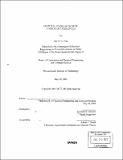| dc.contributor.advisor | Kenneth N. Stevens. | en_US |
| dc.contributor.author | Zhao, Sherry Yi, 1980- | en_US |
| dc.contributor.other | Massachusetts Institute of Technology. Dept. of Electrical Engineering and Computer Science. | en_US |
| dc.date.accessioned | 2006-03-24T16:20:01Z | |
| dc.date.available | 2006-03-24T16:20:01Z | |
| dc.date.copyright | 2003 | en_US |
| dc.date.issued | 2003 | en_US |
| dc.identifier.uri | http://hdl.handle.net/1721.1/29728 | |
| dc.description | Thesis (M.Eng.)--Massachusetts Institute of Technology, Dept. of Electrical Engineering and Computer Science, 2003. | en_US |
| dc.description | Includes bibliographical references (p. 79). | en_US |
| dc.description.abstract | This study used an analysis-by-synthesis approach to discover possible principles governing the coordination of oral and laryngeal articulators in the production of English stop-consonant sequences. Recorded utterances containing stop-consonant sequences were analyzed acoustically, with focus on formant movements, closure durations, release bursts, and spectrum shape at low frequencies. The results of the acoustic analysis were translated into general gestural timing estimates. From these estimates, a set of possible principles was derived. Both the general gestural estimates and the derived principles were verified and refined through quasi-articulatory synthesis using HLsyn. Perception tests composed of synthetic sequences with varying degrees of overlap were administered. From acoustic analysis, synthesis verification, and perception testing, two principles emerged. First, V1Cl#C2V2 stop-consonant sequences with front-to-back order of place of articulation have more overlap of articulators than those with back-to-front order; this agrees with past research findings (Chitoran, Goldstein, and Byrd, 2002). The extent of the overlapping usually does not go beyond the obliteration of the Cl release burst. Second, gestural overlap involving laryngeal articulators exists but varies from individual to individual. The voicing of C1 usually affects the voicing of C2 in V1CI#C2V2 sequences. | en_US |
| dc.description.statementofresponsibility | by Sherry Yi Zhao. | en_US |
| dc.format.extent | 107 p. | en_US |
| dc.format.extent | 4203057 bytes | |
| dc.format.extent | 4202865 bytes | |
| dc.format.mimetype | application/pdf | |
| dc.format.mimetype | application/pdf | |
| dc.language.iso | eng | en_US |
| dc.publisher | Massachusetts Institute of Technology | en_US |
| dc.rights | M.I.T. theses are protected by copyright. They may be viewed from this source for any purpose, but reproduction or distribution in any format is prohibited without written permission. See provided URL for inquiries about permission. | en_US |
| dc.rights.uri | http://dspace.mit.edu/handle/1721.1/7582 | |
| dc.subject | Electrical Engineering and Computer Science. | en_US |
| dc.title | Gestural overlap of stop-consonant sequences | en_US |
| dc.type | Thesis | en_US |
| dc.description.degree | M.Eng. | en_US |
| dc.contributor.department | Massachusetts Institute of Technology. Department of Electrical Engineering and Computer Science | |
| dc.identifier.oclc | 54039846 | en_US |
